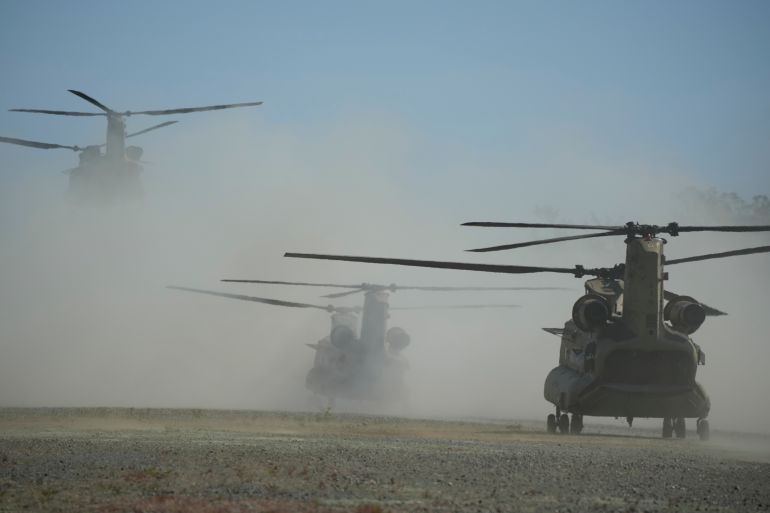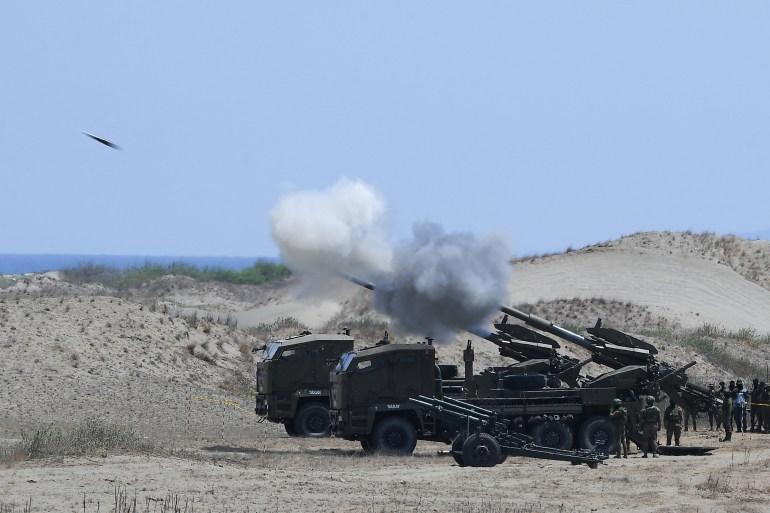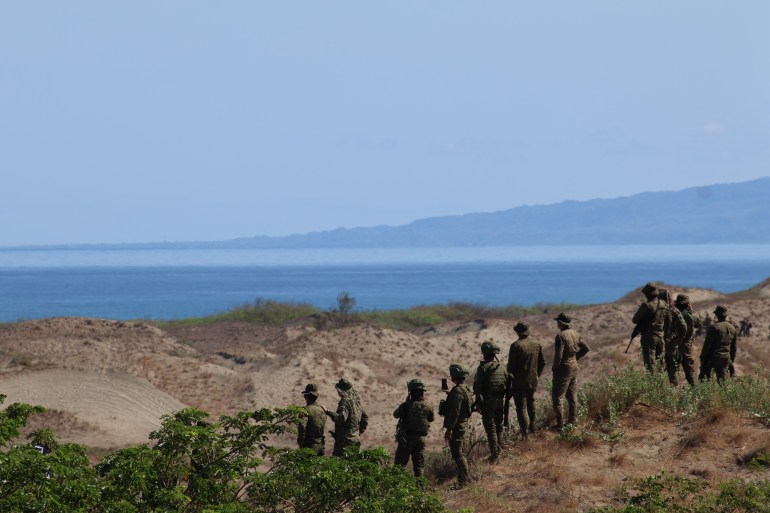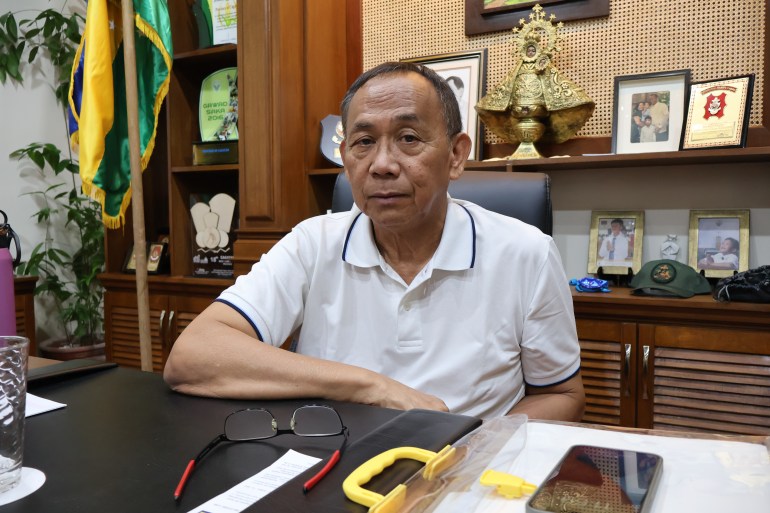Philippines, US simulate mock invasions in largest ever war games
The annual Balikatan joint military exercises conclude on Friday after weeks of live fire drills and new weapons deployments.

Laoag, Philippines – Troops from the United States and the Philippines have launched Javelin missiles and fired howitzers to simulate repelling a maritime invasion along the coast of the South China Sea, in a show of force capping joint war games held in China’s maritime back yard.
The live fire exercises were held throughout the week along the shores of the coastal city of Laoag in northern Ilocos province, the closest mainland Philippine province to China.
Keep reading
list of 4 itemsPhilippines and China in new confrontation at Scarborough Shoal
Marcos Jr treads fine line with China as Philippines deepens US, Japan ties
Japan, Philippines, US rebuke China over ‘dangerous’ South China Sea moves
They capped the largest ever Balikatan, or “shoulder-to-shoulder,” joint military exercises between US and Philippine troops, cementing a dramatic policy shift that has seen Washington and Manila become close allies since Ferdinand Marcos Jr became president in 2022.
Tensions have risen amid multiple confrontations between Philippine vessels and the China Coast Guard in the South China Sea. China claims almost the entire area under its nine-dash line, which was rejected by an international tribunal in 2016.
While the US and Philippine militaries would not name their adversaries, this year’s exercises were concentrated around the northern and western shores of the Philippines — close to the South China Sea and the Taiwan Strait.
Parts of the drills were also staged in waters outside the Philippines’ 19km (12-mile) territorial limit, and also outside Manila’s exclusive economic zone, which extends for 200 nautical miles (about 370km).
“The Philippines and US have a shared vision of a free and open Indo-Pacific,” US Marines Lieutenant General Michael Cederholm, commander of the Balikatan joint task force, told reporters on Monday. “It’s grounded in the seeking of peaceful solutions.
“Make no mistake, if there can’t be a peaceful solution, we have an obligation to our countries to train together.”

Ilocos province lies southeast of China and just south of Taiwan, near areas of the South China Sea that would probably be at the centre of any regional conflict over the disputed waters.
The US and Philippine militaries fired missiles and used howitzer guns stationed along the shore to sink five platoons standing in for amphibious warships.
In northern Batanes, an island province just south of Taiwan, US and Philippine forces simulated the recapture of Itbayat, the country’s northernmost municipality.
The war games elicited a strong response from China, which managed to disrupt at least one live fire exercise in the South China Sea. The Chinese embassy in Manila did not respond to a request for comment from Al Jazeera.
A Chinese warship and two other vessels were spotted near Itbayat as the exercises were held, the Philippine Coast Guard said on Wednesday. The ships left after the coastguard issued a challenge over the radio.
New weapons, equipment
This year’s exercises also showcased new US weapons that could be stationed in the Philippines during a conflict.
For the first time in the Asia Pacific, the US military deployed a new mid-range missile launcher, called the Typhon.

From the northern Philippines, it is able to reach targets in Taiwan, along with Chinese bases and infrastructure in the South China Sea and mainland China.
It is the first such weapon deployed in the region since the US withdrew in 2019 from the Intermediate-Range Nuclear Forces Treaty that barred the development of ground-launched ballistic and cruise missiles with ranges between 500 and 2,500km.
While the Typhon system was not fired during Balikatan, its deployment now serves to identify launch sites that can be used during a conflict, said Collin Koh, a senior fellow at the S Rajaratnam School of International Studies in Singapore.
“During wartime, all you need to do is just go straight to these launch sites and you can set it up and fire immediately without further preparation,” Koh said.
The US and Philippine militaries also used a hovercraft to land a HIMARS missile system on the western island of Palawan, close to contested areas of the South China Sea.
Last year, the militaries tried and failed to land a HIMARS system at the main port of Batanes. This year, the US military upgraded the port, along with a warehouse and other military infrastructure, as part of an effort to develop functional seaports to offload equipment and troops.
“The longer you stay in the port, the more vulnerable you are,” Koh said. “When you are unloading all your equipment and your troops, that is when you are exposed essentially as a sitting duck.”
Local anxieties
Last year, Washington and Manila announced that four military bases would be added to the Enhanced Defense Cooperation Agreement, allowing US troops to utilise a total of nine military sites in the Philippines for training, refuelling and other operations.

Three of those bases are in the northern provinces of Cagayan and Isabela, both close to the Luzon Strait running between the Philippines and Taiwan.
The increasing presence of military troops in civilian areas has alarmed some civilians, worried their location puts them in the path of any future war between the US and China.
“We don’t have to choose between the two,” said Manuel Mamba, governor of Cagayan province. “I do not like foreign forces in my province because I feel we could be dragged into a war which is not ours.”
Mamba has vocally opposed the development of bases in his province for US troops and is among a small yet stubborn contingent of regional and local politicians who have resisted Manila’s turn towards Washington. Marcos Jr’s predecessor Rodrigo Duterte was far closer to Beijing.
Cagayan has received substantial investment from Chinese companies, including an ongoing effort to dredge and develop an international port in the coastal town of Aparri.
The US military builds schools and distributes humanitarian aid during its yearly Balikatan exercises, but Washington has never competed dollar for dollar with the investment promises Beijing can make to local politicians.
Last month, the US and the Philippines announced a new economic investment corridor in Luzon focused on ports, railways and clean energy.

Such US investment would be welcome in Cagayan “if it is not military in nature”, Mamba said. “Maybe [it could be used] only by the Armed Forces of the Philippines if there’s an emergency.”
In Laoag, where live-fire exercises were held, fishermen were ordered not to sail for more than one week. The order cost some fishing boats up to $60 per day in lost income, said Arvin Mangrubang, a priest at the Laoag branch of the Iglesia Filipino Independiente church.
Some communities gave relief stipends of about $9 per day to families that are registered to vote, which Mangrubang said is hardly enough to cover the cost of the exercises to working families.
“We cannot gain anything from that,” he said. “If China reacts to these exercises, the Filipino people will suffer.”